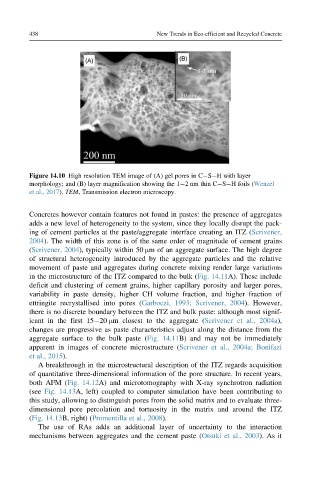Page 488 - New Trends in Eco efficient and Recycled Concrete
P. 488
438 New Trends in Eco-efficient and Recycled Concrete
Figure 14.10 High resolution TEM image of (A) gel pores in C S H with layer
morphology; and (B) layer magnification showing the 1 2 nm thin C S H foils (Wenzel
et al., 2017). TEM, Transmission electron microscopy.
Concretes however contain features not found in pastes: the presence of aggregates
adds a new level of heterogeneity to the system, since they locally disrupt the pack-
ing of cement particles at the paste/aggregate interface creating an ITZ (Scrivener,
2004). The width of this zone is of the same order of magnitude of cement grains
(Scrivener, 2004), typically within 50 μm of an aggregate surface. The high degree
of structural heterogeneity introduced by the aggregate particles and the relative
movement of paste and aggregates during concrete mixing render large variations
in the microstructure of the ITZ compared to the bulk (Fig. 14.11A). These include
deficit and clustering of cement grains, higher capillary porosity and larger pores,
variability in paste density, higher CH volume fraction, and higher fraction of
ettringite recrystallised into pores (Garboczi, 1993; Scrivener, 2004). However,
there is no discrete boundary between the ITZ and bulk paste: although most signif-
icant in the first 15 20 μm closest to the aggregate (Scrivener et al., 2004a),
changes are progressive as paste characteristics adjust along the distance from the
aggregate surface to the bulk paste (Fig. 14.11B) and may not be immediately
apparent in images of concrete microstructure (Scrivener et al., 2004a; Bonifazi
et al., 2015).
A breakthrough in the microstructural description of the ITZ regards acquisition
of quantitative three-dimensional information of the pore structure. In recent years,
both AFM (Fig. 14.12A) and microtomography with X-ray synchrotron radiation
(see Fig. 14.13A, left) coupled to computer simulation have been contributing to
this study, allowing to distinguish pores from the solid matrix and to evaluate three-
dimensional pore percolation and tortuosity in the matrix and around the ITZ
(Fig. 14.13B, right) (Promentilla et al., 2008).
The use of RAs adds an additional layer of uncertainty to the interaction
mechanisms between aggregates and the cement paste (Otsuki et al., 2003). As it

